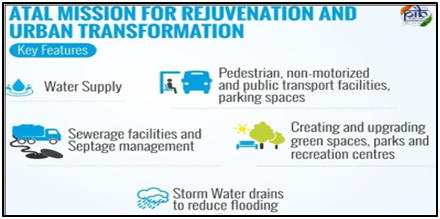Why in news? Around 36% of India’s population is living in cities and by 2047 it will be more than 50%. The World Bank estimates that around $840 billion is required to fund the bare minimum urban infrastructure over the next 15 years. Against this backdrop, the AMRUT (Atal Mission for Rejuvenation and Urban Transformation) scheme was launched in June 2015, with its 2.0 version launched on October 1, 2021.
What’s in today’s article?
- AMRUT
- AMRUT 2.0
- Analysis of AMRUT Scheme
Atal Mission for Rejuvenation and Urban Transformation (AMRUT)
- About
- AMRUT was launched to provide basic civic amenities as to improve the quality of life for all especially the poor and the disadvantaged.
- The focus of the Mission is on infrastructure creation that has a direct link to provision of better services to the citizens.

- The Mission covers 500 cities that includes all cities and towns with a population of over one lakh with notified Municipalities.
AMRUT 2.0
- About
- The target in the second phase of AMRUT is to
- improve sewage and septic management,
- make our cities water safe cities and
- ensure that no sewage drains anywhere in our rivers’
- In other words, AMRUT 2.0 focused on enhancing sewerage and septic management and to make all Indian cities water secure.
- Aim
- providing 100% coverage of water supply to all households in around 4,700 urban local bodies by providing about 2.68 crore tap connections
- 100% coverage of sewerage and septage in 500 AMRUT cities by providing around 2.64 crore sewer or septage connections
- Principles and Mechanism
- AMRUT 2.0 will adopt the principles of circular economy and promote conservation and rejuvenation of surface and groundwater bodies.
- The Mission will promote data led governance in water management and Technology Sub-Mission to leverage latest global technologies and skills.
- ‘Pey Jal Survekshan’ will be conducted to promote progressive competition among cities.
- Coverage
- Extends coverage from 500 cities under the first phase to 4,700 cities and towns.
- It will benefit more than 10.5 crore people in urban areas.
Analysis of AMRUT scheme
- Performance of scheme
- The AMRUT dashboard shows that as of May 2024, a sum of ₹83,357 crore has been dispersed so far.
- This amount has been utilised to provide a total of 58,66,237 tap connections, and 37,49,467 sewerage connections.
- A total of 2,411 parks have been developed, and 62,78,571 LED lights have been replaced.
- Criticism
- It is estimated that about 2,00,000 people die every year due to inadequate water, sanitation and hygiene.
- In 2016, the disease burden due to unsafe water and sanitation per person was 40 times higher in India than in China. This has not improved much.
- Huge amounts of waste water and little treatment enhances the vulnerability and incidence of diseases.
- Around 21 major cities are going to run out of ground water. In a NITI Aayog report it was stated that 40% of India’s population will have no access to drinking water by 2030.
- Nearly 31% of urban Indian households do not have piped water; 67.3% are not connected to a piped sewerage discharge system.
- Average water supply per person in urban India is 69.25 litres/day, whereas the required amount is 135 litres.
- Additionally, air quality in AMRUT cities and in other large urban settlements continue to worsen.
- A National Clean Air Programme was launched by the central government in 2019, as AMRUT 2.0 focused only on water and sewerage.
- Challenges
- The AMRUT scheme was fundamentally flawed, adopting a project-oriented rather than holistic approach.
- It lacked city participation and was driven by bureaucrats, parastatals, and private companies, with minimal involvement from elected city governments.
- Governance was dominated by non-elected officials, violating the 74th constitutional amendment.
- The apex committee was headed by the MOHUA secretary, and state committees were led by chief secretaries.
- It excluded people's representatives and favored a private nexus of consultants and professionals.
- Water management in cities must consider climate, rainfall patterns, and existing infrastructure.
- Sewage treatment plants are inefficiently designed, with faecal matter traveling longer distances than the average worker's commute.
- Urban planning, driven by private players and real estate developers, often leads to the disappearance of water bodies, disrupted storm water flows, and a lack of proper storm water drainage systems.
- Way forward
- The scheme needs nature-based solutions and a comprehensive methodology with a people centric approach and empowering local bodies.










